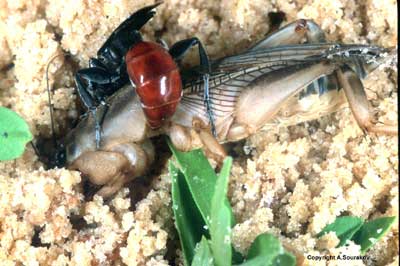|
Neoscapteriscus vicinus (Scudder)
(Ney-oh-scap-terr-ISK-us viss-SIGN-us)
|
Distribution
The tawny mole cricket is originally from southern South America. It arrived in Florida and Georgia about 1900 and spread north and west. It occurs in all the southeastern states, but not, so far, in Puerto Rico or the Virgin Islands. It is currently found in Florida, Georgia, South Carolina, North Carolina, Alabama, Mississippi, Louisiana, and Texas. r
Tawny mole cricket populations continue to spread north and west. Colder temperatures ultimately will limit the spread of tawny mole crickets to the north. While there is no evidence that they will not spread farther west, arid conditions may hinder them. In drought, mole crickets risk desiccation and seek moister locations or conditions deeper in the soil. They dig to the surface of flooded soil.
Description
The tawny mole cricket is a mole cricket of average appearance that typically does not play dead when captured, as do the West Indian and southern mole crickets. The imitator mole cricket also will not play dead when captured. The tawny mole cricket does not move very rapidly, and its wings are longer than the body.
The tawny mole cricket has only two dactyls on its tibia, as is common with all the Neoscapteriscus species described here. The tibial dactyls are very close together, almost touching, being separated at their base by less than 0.15 mm. The ocelli are small, nearly circular, and widely separated. The thorax is tawny with a distinctly marked, short, ovoid pronotum. The color pattern of the dorsal side of the thorax is helpful in distinguishing among Neoscapteriscus species.
|
|
Tawny mole cricket songs are continuous trills that differ in tone (carrier frequency, measured in kHz) and pulse rate (pulses/second) from those of the southern mole cricket.
Life Cycle
In the southeastern United States, the tawny mole cricket has one generation annually. Eggs are laid in underground chambers in April through June. Each adult female may lay several clutches of eggs if she survives long enough. Each clutch typically contains 24 to 60 eggs. Egg chambers are 4 to 12 inches underground. The female closes the entrance to the chamber after she has oviposited. Eggs incubate for about three weeks. Most of the parental mole crickets die off during the months of May and June. Female mole crickets in captivity will not lay eggs outside the normal April–June oviposition season.
Hatchling nymphs are white at first but they darken within a day or so. Nymphs are cannibalistic at first. They tunnel out of the egg chamber and begin to feed on plant roots. They feed and grow throughout the summer months, molting six or seven times in the process. By early September the first of them have reached the adult phase, and most reach it during the next few months; only a few remain as nymphs during the winter months. These overwintering mole crickets breed the following spring.
The presence of adult tawny mole crickets is most obvious during their springtime flights. In Florida, these flights are in February – April and begin and end several weeks earlier in the south than in the north. In Georgia, flights do not begin until late March and persist through May. Adult mole crickets also fly to a limited extent in October – November. The maximum number of tawny mole crickets occurs in the summer months, but these are nymphs and, of course, do not fly.
Tawny mole cricket flights begin soon after sunset and end after little more than an hour.
Life cycles of other species are contrasted in this tutorial with that of the tawny mole cricket, because it is the best-studied species.
Damage
The tawny mole cricket is a major pest of vegetable seedlings, turf and pasture grasses. Tawny mole crickets feed largely on plant material, and only to a slight extent on insects and other animals.
Ormia depleta (Wiedemann) is a species of tachinid fly native to South America. In the 1930s in Amazonian Brazil, its larvae were found to be parasitoids of Neoscapteriscus mole crickets. An unsuccessful attempt was then made to introduce the fly into Puerto Rico as a biological control agent for the West Indian mole cricket. In the 1980s in Paraguay, adult female Ormia depleta were found to be attracted to songs of tawny and southern mole crickets when these songs were produced artificially by a sound emitter developed by the UF/IFAS mole cricket program.
|
Steinernema scapterisci Nguyen & Smart is a species of steinernematid nematode native to South America. Initial tests showed that S. scapterisci killed all tawny mole crickets exposed to it. This is an important biological control agent because infected adult tawny mole crickets can fly at least a mile, and when they die, release third-stage juvenile nematodes into the soil.
|
Larra bicolor F. is a species of crabronid wasp native to South America. Introduction of L. bicolor stock from Puerto Rico, originally from Amazonian Brazil, into Florida in 1979–1982 led to its establishment at Ft. Lauderdale. Introduction of stock from Bolivia into Florida in 1988–1989 led to its establishment at Gainesville.
 |